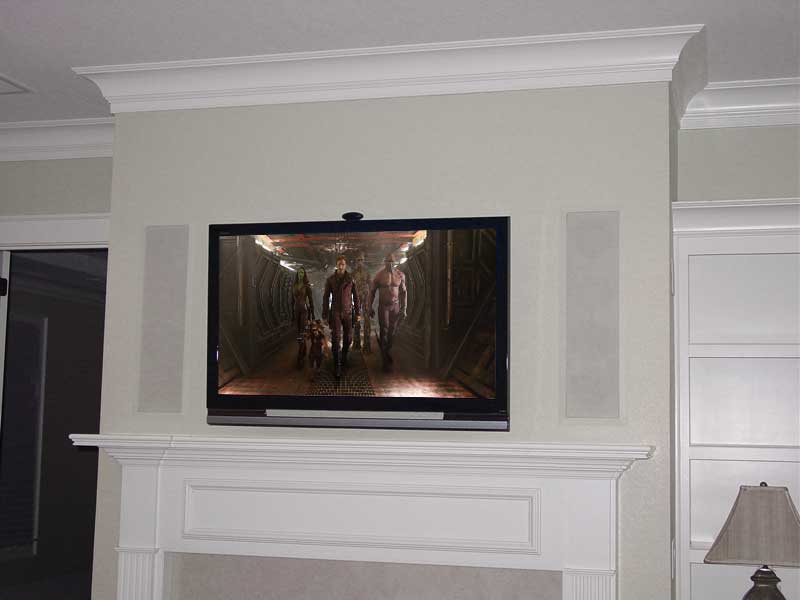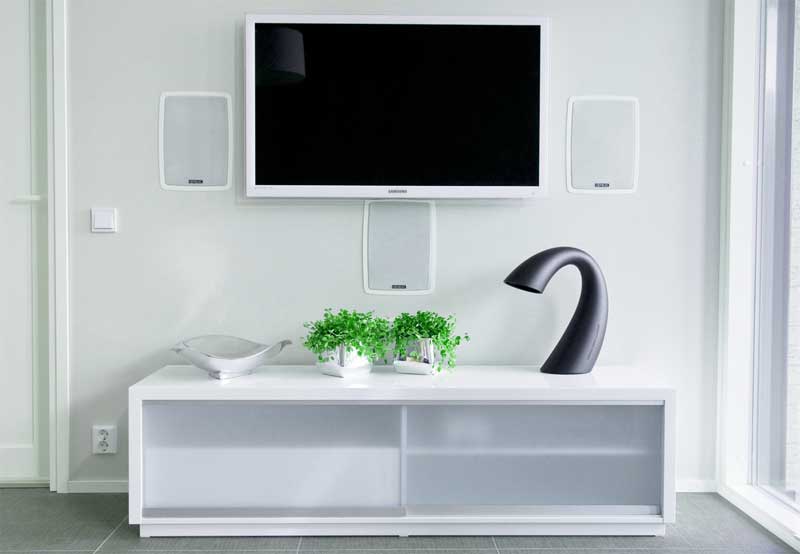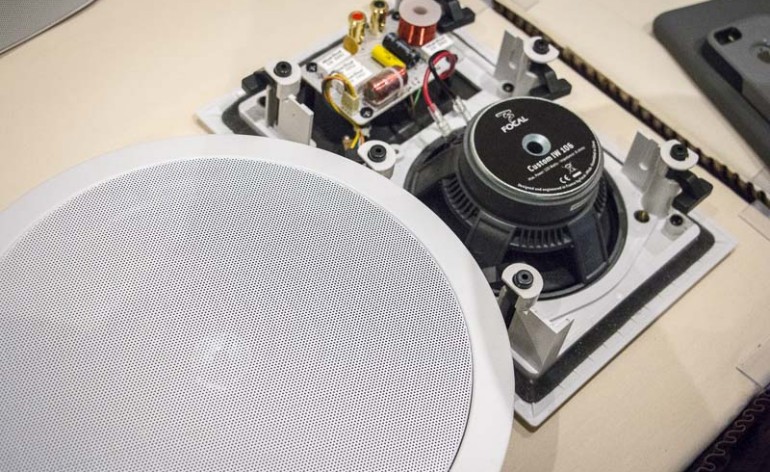The Case Against In-Wall Home Theater Speakers
There are lots of reasons to want in-wall speakers in your home theater. They give that “clean” look that so many picture when they start planning their rooms. And…that’s about it. The only reason to really want in-wall speakers is that it makes your home theater look sleeker. For me, that’s not reason enough. So, here is my case against using in-wall speakers in your home theater.
Author’s Note: We’ve talked about in-walls speakers before. There are many considerations when deciding to use in-wall speakers. If you have limited room, or need to maximize space, then in-wall speakers might be your only option. But for many, the decision to use in-wall speakers is purely an aesthetic one.
Placement of In-Wall Speakers is Harder than You Think
When you glance around your room, you may pick out the perfect locations for your speakers. Hey, they go in the wall! You just cut a hole and install! Right?
Wrong.
Your walls are full of stuff. Is it an exterior wall? Is your house brick or concrete block? You might be looking at as little as 1″ furring strips mounted to the block behind. That doesn’t leave a lot of room for a speaker, does it? Plus, there are studs, wires, HVAC, and other things behind your drywall. Just because you can see where the perfect spot would be, doesn’t mean your in-wall speakers can actually be installed there.

Running Wires
There are lots of ways to run wires. If you have access to an attic or crawl space, running a wire inside a wall usually isn’t much of a problem. If you don’t, you’ll need some way to hide the wires inside the room. Regardless, it makes no sense to install in-wall speakers in your home theater and not run the wires in the wall. This adds to the complexity and cost of the speaker installation.
In-Wall Home Theater Speakers are a Compromise Sonically
If you really want the best sounding speakers possible, you don’t want in-wall speakers. Dollar for dollar, they just don’t sound as good. They often are relying on the space in the wall as their backbox (more on this later) which changes how they sound. Therefore, the same speaker, in a different wall, can sound dramatically different.
On top of that, your in-wall speakers are often not the only thing that is on your walls. Did you hang some acoustic panels (we hope you did)? What about a shelf for knickknacks? Is there a corner near your speaker placement? All these things will affect the sonic characteristics of your in-wall speaker. Sure they are practically invisible, but didn’t you spend the money on them so that they’d sound good?
Paintable Grilles are a Pain
And speaking of “practically invisible,” in-wall speakers really aren’t. Sure, you may not notice them at first, but you can totally see the grilles. Everyone promises that their grilles are paintable. Well, that means you need to paint them. And Lord help you if you put just a touch too much paint on them! All those grille holes quickly fill up. You’ll find yourself poking them all clear with an icepick or a stack of toothpicks (speaking from personal experience here).

Even if you do paint them, they still are visible. There is clearly a speaker in the wall of your home theater. Plus, half the time you can see through the grilles enough to know it is a speaker your looking at. This is especially true if you speakers have non-black drivers (looking at you Klipsch). If the point is to not see speakers, in-wall speakers barely clear the bar.
The Hidden Cost of In-Wall Speakers
Most in-wall speakers these days do not come with backboxes. If you want your new in-wall speakers to sound as good as possible. you are going to want a backbox. If you want to keep the sound in the home theater and not transmitting unfettered to the rest of the house, you want backboxes.
A backbox is exactly what it sounds like – a box behind your in-wall speaker. Some companies sell backboxes for their speakers (separately), but many don’t. They’ll tell you the optimal volume of a backbox, but you’ll have to build it yourself. And fill it with insulation. And decouple it from the structure of your home.
As you can see, it isn’t as easy as cutting a hole in your wall.
Now, if you picked speakers with integrated backboxes, you are in luck. But you still need the aforementioned paint. And no, you can’t use the extra can you have lying around. If you want to spread the paint evenly and avoid having to clear the grille holes of paint, you are going to want a spray can. And that costs extra.

Forget About Changes
If you decide later on that you want to change or upgrade your speakers, you’ve got another problem. You either need a speaker of the same size or larger or you are going to have to do some drywall patching. No matter how you look at it, if you install in-wall speakers in your home theater, you’ll be stuck with them for life.
If you do your research, you should be fine. A good-sounding speaker should continue to sound good for years. But what the unthinkable happens? What if one breaks, one of your in-wall wires gets a nail shoved through it, or Dolby decides that your speakers should be in different locations (like they did for Atmos)? Moving, replacing, and/or servicing in-wall speakers is no small feat.
Not only that, no other changes can be made to your room easily. Want to move your couch or upgrade to a larger one? Well, now your surround speakers are in the wrong position. No longer like the color you chose for your home theater? Whelp, your in-wall speaker grilles will need to be painted again as well. And if you placed your front speakers so that they flank your screen, you’ve locked yourself into that screen size for life! You can’t even move your couch forward to make the screen look bigger because that changes the angles of your in-wall speakers and in-ceiling Atmos speakers!
While we can understand wanting that clean look of an in-wall speaker system in a home theater, it seems way too permanent to us.
The Solution: On-Wall Speakers
There are lots of solutions for this problem. One of the easiest, and the one that gets you closest to the in-wall look, is on-wall speakers. These speakers are thin and are meant to sit very flush to the wall. Because they aren’t in-wall, most of our objections to in-walls melt away. While they won’t give you quite that “clean” look of an in-wall speaker, they are infinitely easier to deal with and will ultimately be more flexible. You can upgrade, move, and service them much easier. They could be wrapped in acoustically transparent fabric the same color as your wall for a cleaner look. Plus, there are tons of options. If you really want the highest quality on-wall speakers, check out Legacy Audio. They are huge, but they sound great.
If you have in-wall speakers and you love them, I have nothing against you. They can be very effective and look great. But as some seem to hold them up as the “gold standard” for custom home theaters, I feel it is important to acknowledge their limitations.



Thanks for the Legacy Audio recommendation. Any recommendations on how to purchase them?
They are dealer-only. They have a list of dealers on their website or you can contact them to see where you can shop closest to you.
I think you’re biased and maybe need to experience a professionally installed wall and ceiling speaker.
My new Klipsch 5502 and 5800’s sound amazing and I haven’t even tuned the Yamaha avr yet.
Granted, It is in a new home and all wiring and preconstruction brackets done before drywall.